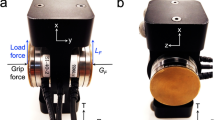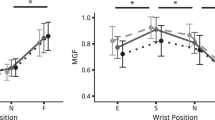Abstract
Grip strength loss in extended and flexed wrist postures has been explained by reduced force-generating capacities of extrinsic finger flexor resulting from non-optimal length, owing to the force–length relationship. Recent works suggested that other muscles, especially wrist extensors, participate in this grip strength loss. The objective of this study was to clarify the role of the force–length relationship in finger force production. 18 participants performed maximal isometric finger force production during pinch grip (Pinch) and four-finger pressing (Press) tasks in four different wrist postures (extended, flexed, neutral, spontaneous). The maximum finger force (MFF), finger and wrist joint angles, as well as activation of four muscles were determined using dynamometry, motion capture, and electromyography. The force and length of the four muscles were estimated from joint angles and muscle activation using a musculoskeletal model. MFF decreased for flexed wrist during Pinch but remained stable across wrist postures during Press. The results suggested that the loss of pinch grip force in deviated wrist posture is partially related to force–length relationship of finger extensors. In opposition, MFF during Press was not influenced by the modulation of muscle capacities but was probably first limited by mechanical and neural factors related to finger interdependence.





Similar content being viewed by others
References
Anderson, D. R., K. P. Burnham, and G. C. White. Comparison of Akaike information criterion and consistent Akaike information criterion for model selection and statistical inference from capture-recapture studies. J. Appl. Stat. 25:263–282, 1998.
Caumes, M., B. Goislard de Monsabert, H. Hauraix, E. Berton, and L. Vigouroux. Complex couplings between joints, muscles and performance: the role of the wrist in grasping. Sci. Rep. 9:1–11, 2019.
Charissou, C., D. Amarantini, R. Baurès, E. Berton, and L. Vigouroux. Effects of hand configuration on muscle force coordination, co-contraction and concomitant intermuscular coupling during maximal isometric flexion of the fingers. Eur. J. Appl. Physiol. 117:2309–2320, 2017.
Criswell, E. Cram’s Introduction to Surface Electromyography. Sudbury, MA: Jones and Bartlett, p. 412, 2011.
de Brito Fontana, H., and W. Herzog. Vastus lateralis maximum force-generating potential occurs at optimal fascicle length regardless of activation level. Eur. J. Appl. Physiol. 116:1267–1277, 2016.
Dempsey, P. G., and M. M. Ayoub. The influence of gender, grasp type, pinch width and wrist position on sustained pinch strength. Int. J. Ind. Ergon. 17:259–273, 1996.
Domalain, M., L. Vigouroux, F. Danion, V. Sevrez, and E. Berton. Effect of object width on precision grip force and finger posture. Ergonomics. 51:1441–1453, 2008.
Erdemir, A., S. McLean, W. Herzog, and A. J. van den Bogert. Model-based estimation of muscle forces exerted during movements. Clin. Biomech. 22:131–154, 2007.
Goislard de Monsabert, B., H. Hauraix, M. Caumes, A. Herbaut, E. Berton, and L. Vigouroux. Modelling force-length-activation relationships of wrist and finger extensor muscles. Med. Biol. Eng. Comput. 58:2531–2549, 2020.
Goislard de Monsabert, B., G. Rao, A. Gay, E. Berton, and L. Vigouroux. A scaling method to individualise muscle force capacities in musculoskeletal models of the hand and wrist using isometric strength measurements. Med. Biol. Eng. Comput. 55:2227–2244, 2017.
Goislard de Monsabert, B., J. Rossi, E. Berton, and L. Vigouroux. Quantification of hand and forearm muscle forces during a maximal power grip task. Med. Sci. Sports Exerc. 44:1906–1916, 2012.
Halpern, C. A., and J. E. Fernandez. The effect of wrist and arm postures on peak pinch strength. J. Hum. Ergol. 25:115–130, 1996.
Hauraix, H., B. Goislard De Monsabert, A. Herbaut, E. Berton, and L. Vigouroux. Force-length relationship modeling of wrist and finger flexor muscles. Med. Sci. Sports Exerc. 50:2311–2321, 2018.
Hazelton, F. T., G. L. Smidt, A. E. Flatt, and R. I. Stephens. The influence of wrist position on the force produced by the finger flexors. J. Biomech. 8:301–306, 1975.
Imrhan, S. N. The influence of wrist position on different types of pinch strength. Appl. Ergon. 22:379–384, 1991.
Keir, P. J., A. Farias Zuniga, D. M. Mulla, and K. G. Somasundram. Relationships and mechanisms between occupational risk factors and distal upper extremity disorders. Hum. Factors J. Hum. Factors Ergon. Soc. 63:5–31, 2021.
Leedham, J. S., and J. J. Dowling. Force-length, torque-angle and EMG-joint angle relationships of the human in vivo biceps brachii. Eur. J. Appl. Physiol. 70:421–426, 1995.
Li, Z.-M., M. L. Latash, and V. M. Zatsiorsky. Force sharing among fingers as a model of the redundancy problem. Exp. Brain Res. 119:276–286, 1998.
Maier, M. A., and M. C. Hepp-Reymond. EMG activation patterns during force production in precision grip. I. Contribution of 15 finger muscles to isometric force. Exp. Brain Res. 103:108–122, 1995.
O’Driscoll, S. W., E. Horii, R. Ness, T. D. Cahalan, R. R. Richards, and K.-N. An. The relationship between wrist position, grasp size, and grip strength. J. Hand Surg. 17:169–177, 1992.
Rassier, D. E., B. R. MacIntosh, and W. Herzog. Length dependence of active force production in skeletal muscle. J. Appl. Physiol. 86:1445–1457, 1999.
Sanei, K., and P. J. Keir. Independence and control of the fingers depend on direction and contraction mode. Hum. Mov. Sci. 32:457–471, 2013.
Snijders, C. J., A. C. Volkers, K. Mechelse, and A. Vleeming. Provocation of epicondylalgia lateralis (tennis elbow) by power grip or pinching. Med. Sci. Sports Exerc. 19:518–523, 1987.
Tosti, R., J. Jennings, and J. M. Sewards. Lateral epicondylitis of the elbow. Am. J. Med. 126:357.e1-357.e6, 2013.
Valero-Cuevas, F. J., F. E. Zajac, and C. G. Burgar. Large index-fingertip forces are produced by subject-independent patterns of muscle excitation. J. Biomech. 31:693–703, 1998.
Vergara, M., J. L. Sancho-Bru, V. Gracia-Ibáñez, and A. Pérez-González. An introductory study of common grasps used by adults during performance of activities of daily living. J. Hand Ther. 27:225–234, 2014.
Vigouroux, L., M. Domalain, and E. Berton. Effect of object width on muscle and joint forces during thumb-index finger grasping. J. Appl. Biomech. 27:173–180, 2011.
Winter, S. L., and J. H. Challis. The force-length curves of the human rectus Femoris and gastrocnemius muscles in vivo. J. Appl. Biomech. 26:45–51, 2010.
Funding
The authors received no external funding for the work presented in this article.
Author information
Authors and Affiliations
Corresponding author
Ethics declarations
Conflict of interest
The authors certify that they have no conflict of interest in the subject matter or materials discussed in this manuscript.
Additional information
Associate Editor Michael R. Torry oversaw the review of this article.
Publisher's Note
Springer Nature remains neutral with regard to jurisdictional claims in published maps and institutional affiliations.
Supplementary Information
Below is the link to the electronic supplementary material.
Rights and permissions
Springer Nature or its licensor (e.g. a society or other partner) holds exclusive rights to this article under a publishing agreement with the author(s) or other rightsholder(s); author self-archiving of the accepted manuscript version of this article is solely governed by the terms of such publishing agreement and applicable law.
About this article
Cite this article
Goislard de Monsabert, B., Caumes, M., Berton, E. et al. Influence of Force–Length Relationship and Task-Specific Constraints on Finger Force-Generating Capacities. Ann Biomed Eng 51, 2453–2464 (2023). https://doi.org/10.1007/s10439-023-03276-0
Received:
Accepted:
Published:
Issue Date:
DOI: https://doi.org/10.1007/s10439-023-03276-0




